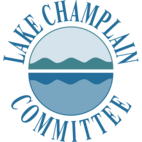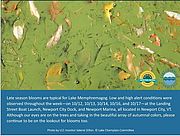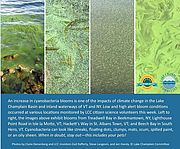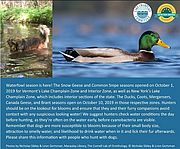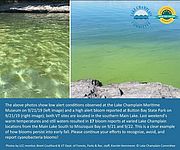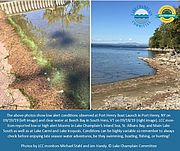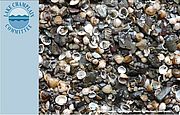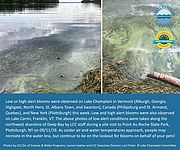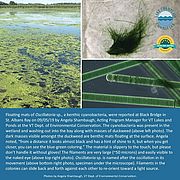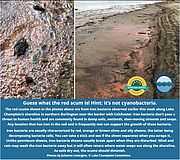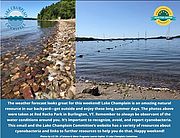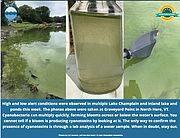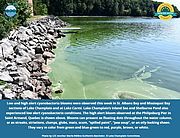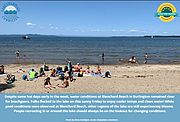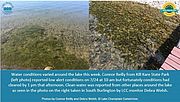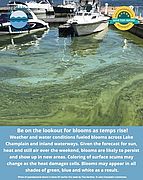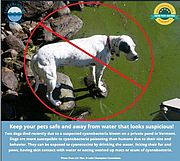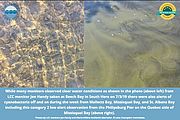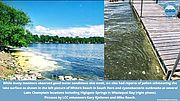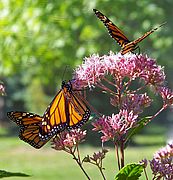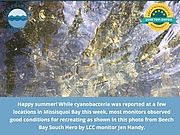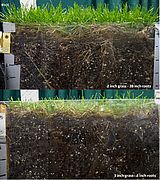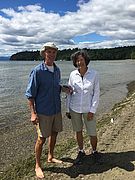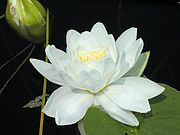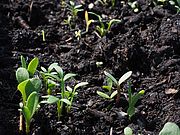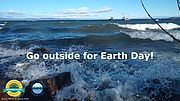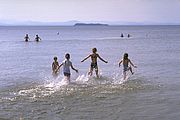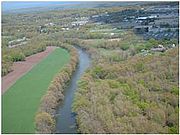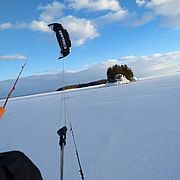Blooms were experienced this week in Lake Champlain’s St. Albans Bay and Main Lake North, as well as Lake Carmi and Lake Memphremagog. We’ve had a blustery few days, with strong winds triggering lots of wave action on our waterways. In addition to breaking up existing surface accumulations, the windy weather and power outages also affected some monitors’ ability to report. Read...
News from Selected Month
We had some great weather for leaf peeping this week but unfortunately, those moderate temperatures and sunny, calm days also helped cyanobacteria blooms flourish. High alert or mixed conditions were witnessed in Lake Champlain’s St. Albans Bay, the Inland Sea, Malletts Bay, Main Lake North, Main Lake Central and Main Lake South as well as in Lake Carmi and Lake Memphremagog. Read...
As temperatures cool and hues of orange, yellow and red color the hillsides, we hope you are enjoying autumn’s beauty. Although blooms are less likely as air and water temperatures drop and frost warnings are in effect, cyanobacteria can still persist or pop up. While there were plenty of reports of clear water this week, blooms continued to show up in Lake Champlain and an inland waterway. Read...
Unseasonably warm weekend weather triggered a spate of 17 bloom reports on 9/21 and 9/22. More blooms followed during the week, with some monitors reporting their first blooms of 2019. With temperatures predicted to rise into the 70s on Saturday, we anticipate some blooms will continue to persist for a while and that cyanobacteria may pop up in new locations. Read...
The time to prepare for future floods is now. Communities that took steps to protect themselves in advance of Tropical Storm Irene were often able to avoid some of the devastation that confronted their neighbors. Read...
Today marks the global climate strike followed by a week of events to highlight the urgency of climate action. Water is a primary medium through which we feel the effects of climate change. Declining water quality is another consequence of a warming planet. As air temperatures rise, so too do water temperatures. Read...
Has the invasive Asian clam made it into Lake Champlain? Join us in our surveying efforts to find out!
We are teaming up with our friends at Arrowwood Environmental and Magic Hat Brewing Company to comb Burlington area beaches for the invasive mollusk. The program includes training, field time, and lunch! It’s a great way to learn more about Asian clams, how to identify them and what we can do to keep them out of Lake Champlain. Read...
Mixed conditions were reported again this week on Lake Champlain in Missisquoi Bay, St. Albans Bay, and the Inland Sea, and also at Lake Carmi. The floating mats of the benthic cyanobacteria Oscillatoria sp. that we showed you pictures of last week were still present at Black Bridge in St. Albans Bay on 9/10/19, but to a lesser extent. Monitors also observed mixed conditions in the Main Lake North section of Lake Champlain. Read...
Kids are back at school, seasonal staff are leaving beach and park areas, and there’s a hint of fall in the air this first week of September. However, cyanobacteria can still flourish even when autumn colors begin to show on the hillsides which is why the Lake Champlain Committee Cyanobacteria Monitoring Program continues through the end of October. Read...
It was another busy week for <link about-lcc>Lake Champlain Committee (LCC) monitors with alert level conditions reported from Lake Champlain’s Missisquoi Bay, St. Albans Bay, Inland Sea, Main Lake North, Main Lake South, and South Lake. Cyanobacteria was also reported at Colchester Pond, Lake Carmi, Lake Memphremagog, Nichols Pond, and Shelburne Pond. Bulwagga Bay Beach in Moriah NY was closed on Sunday August 25 due to a bloom but has since re-opened. Read...
We hope you’ve been enjoying the cooler temperatures and lower humidity this week. Here are results from our tenth week of the Lake Champlain Committee (LCC) cyanobacteria monitoring program. You’ll find resources and links to help you identify, report and avoid cyanobacteria. We’ve also included pictures of some of the conditions observed this week along with photos of a stick test you can use to help you differentiate cyanobacteria from non-toxin producing green algae. Please continue to share these resources with others to help educate people on water issues.
Read...
Alert level conditions were reported from several Lake Champlain locations and inland lakes this week including Lake Champlain’s inland sea, St. Albans and Missisquoi Bays and at Indian Brook Reservoir, Lake Carmi and Shelburne Pond. Scattered storms are predicted for the weekend before a rise in temperatures next week so pease be on the lookout for blooms and avoid contact with anything that looks suspicious. Read...
While there were many reports of generally safe conditions this week several sections of Lake Champlain as well as some inland waterways continue to be plagued by mixed conditions. Read LCC's latest report on cyanobacteria conditions for the week of 8/4/19. Read...
Lake Champlain Committee Monitors filed 177 reports this week! Blooms appeared in four Lake Champlain regions: Missisquoi Bay, St. Albans Bay, Inland Sea, and Main Lake Central. There were also bloom conditions at Lake Carmi and Shelburne Pond. Warm weather is predicted for this weekend. Please be on the lookout for blooms and avoid contact with anything that looks suspicious.
Over 216 reports were filed this week from Lake Champlain and inland waterways. Blooms were observed in all regions of Lake Champlain, except Malletts Bay and South Lake; Lake Carmi also had reports of cyanobacteria. Sun and heat are in the forecast for Saturday—be on the lookout for blooms!
Lake Champlain Committee monitors filed over 196 reports this week for Lake Champlain and inland waterways. While there were plenty of reports of clear water, blooms proliferated in parts of Missisquoi Bay, St. Albans Bay, the Inland Sea, Main Lake Central and Main Lake South. Shelburne Pond and Lake Carmi also had reports of cyanobacteria. Several beaches were closed in both New York and Vermont.
We saw a lot of volatility in conditions this week on Lake Champlain. Heavy rains flushed things out in some areas and in others provided additional nutrients to fuel cyanobacteria growth. Blooms showed up along the New York shoreline, in St. Albans Bay, Missisquoi Bay and along the Burlington and South Burlington shorelines and at Vermont inland waterways of Bald Hill Pond and Shelburne Pond. We also received word that two dogs recently died due to ingesting cyanobacteria from a private pond in Vermont. Please remind dog owners to be vigilant about protecting their pets and keep them away from water with cyanobacteria.
We had over 150 water quality observations from Lake Champlain and inland waterway monitors this week! Most were of good conditions but cyanobacteria was reported from Lake Champlain sites in Malletts Bay, St. Albans Bay and Missisquoi Bay. You’ll find further information and links below about cyanobacteria and how to recognize and report it. We’ve also included a photo of a mystery phenomena we are trying to identify (stay tuned for results next week) and a picture of the invasive fishhook waterflea. Populations of this aggressive, predatory zooplankton have increased dramatically since they were first discovered in Lake Champlain last September.
We had reports from 135 different sites this week with low alert sitings of cyanobacteria from Lake Champlain’s Missisquoi Bay, St. Albans Bay and Knapp Pond in Cavendish, VT. High alert bloom conditions persisted at Outer Malletts Bay on June 26 and 27 and improved to low alert conditions on Friday. Happily, most other monitors reported good conditions.
This article is a continuation of the fall 2018 article on raising Monarch butterflies for the fall migration. Both articles were written by Laura Pratt, LCC’s current ECO AmeriCorps Education & Outreach Coordinator, who raised monarchs in her home last year. Monarch butterflies are important pollinators in the Lake Champlain watershed. They rely on milkweed during their caterpillar stage – a plant which is growing scarce with an increase in urbanization and pesticide use. However, you can make a difference by planting native varieties of milkweed in your garden, encouraging your town to replace lawn with pollinator gardens where possible, and even by raising monarch butterflies yourself!
Happy start of summer! Cyanobacteria monitoring got underway earlier this week, toxin testing and phytoplankton analysis at selected shoreline locations on Lake Champlain will get underway next week as well. We are excited to have such a great crew of citizen scientists assessing water conditions! Low alert conditions were observed on the eastern side of Missisquoi Bay and some cyanobacteria was seen in the water at Niquette Bay State Park this week. All other areas of Lake Champlain along with inland Vermont lakes reported good conditions. Read...
Grass is the largest irrigated crop in the United States. It covers city parks, suburban lawns, and wide-open rural fields. Unfortunately, grass can be a major source of fertilizer runoff. While the best way to slow rainwater down and allow pollutants to settle out is to plant native grasses, shrubs, and trees instead of the traditional lawn, there are still things you can do to make your lawn green, healthy, and watershed friendly.
Help assess Lake Champlain water conditions around the lake. Complete our cyanobacteria monitor interest form if you're interested in monitoring or want to attend a training session to learn more about the lake. Feel free to share this invite with other lake lovers.
Spring isn’t just a time when trees and flowers are coming alive – plants are also opening up throughout the ponds, lakes, and waterways. While aquatic plants may look similar to their land-bound counterparts, they have evolved to endure an environment where light is often scarce and concentrations of atmospheric gases are low. These adaptions are clearly displayed in the variations between aquatic leaves.
Soil isn’t just the dirt we might think of when we wash our hands or take our shoes off at the door. Healthy soil is alive – it’s full of layered root systems, microbial communities, organic matter, worms, bugs, and fungi. It’s an entire ecosystem that powers all life above it. It can sequester carbon, hold water, and support healthy plant life – all of which are vital to turning the tide on climate change. And, most importantly for Lake Champlain’s water quality, soil with just a 1% increase in organic matter in the top six inches can hold over 20,000 gallons of water per acre.
Walk, run, hike, bike in the great outdoors. Breath some fresh air, get a little dirty or wet, take in the sunshine – or the rain (or snow), watch the stars. Commune with nature. Getting out into the greenery is known to brighten moods and improve health. To celebrate this year's Earth Day LCC has several ideas for going all out to enjoy and protect our environment!
Nestled between the Adirondacks and the Green Mountains, Lake Champlain is no stranger to cold, snowy winters. Wild ice – ice which forms naturally on lakes and ponds – is a special attribute of northern climes. Ice skating, skiing, show-shoeing, kiting, and fishing all rely on a thick layer of ice forming during the winter months. However, thaws can happen at any time during the ice season, and with climate change winter temperatures are becoming more unpredictable. Learn more about the stages of a thaw on lake ice, and how to stay safe throughout the winter.
LCC is looking to expand our photo stock of pictures for our articles, slideshows, social media, and website, and we need your help to do it! Whether it’s covered in ice or reflecting the summer sky, Lake Champlain is a stunning part of the natural landscape. From a beautiful vista, an unusual water phenomenon, or people exploring the lake, we welcome all of your photos. Submit your pictures of life on and around the water (swimming, fishing, skating, boating, natural history and more!) and help us share images of Lake Champlain in all its moods and magic.
Do you own property along a waterway in New York? Through the “Buffer in a Bag” initiative, New York State Department of Environmental Conservation’s (NYS DEC) Trees for Tribs Program and the NYS Tree Nursery will provide landowners with a free bag of 25 bare-root native trees and shrubs to enhance streamside areas of property. Riparian buffers – the term used to describe these vegetated shoreline zones – are vital to water quality. They allow stormwater to settle out before entering tributaries, which reduces pollution and sedimentation. They also provide wildlife habitat, prevent erosion, and increase the land’s ability to retain floodwaters.
Throughout the winter, Lake Champlain’s vast tracts of ice and snow provide the perfect conditions for snowkiters like Gary Kjelleren. A brand-new sport in the late 1990s, kitesailing (the summer version of snowkiting) quickly took off in popularity. A kitesailer uses a large sail-like kite to catch the wind, while they skim and jump over the water’s surface on a finned water board. Anyone who has spent time on the shores of a large lake or ocean is likely familiar with the colorful, crescent-shaped kites that swoop jauntily through the air, a small human figure skipping along behind them.
